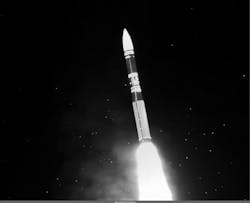Air Force picks General Dynamics to provide radiation-hardened communications for U.S. strategic forces
HANSCOM AIR FORCE BASE, Mass. – Satellite communications (SATCOM) experts at General Dynamics Corp. are building secure and hardened communications systems that are immune to the effects of nuclear explosions for U.S. strategic forces.
Officials of the Nuclear Networks Division at Hanscom air Force Base, Mass., announced a potential $226.5 million contract Monday to the General Dynamics Mission Systems segment in Taunton, Mass., for the Global Aircrew Strategic Network Terminal (ASNT) Increment 2, Block 1 project.
The contract calls for General Dynamics to build high-altitude electromagnetic pulse and radiation-hardened general area alerting, personal area alerting, and ultra-high frequency line-of-sight communications to aircraft at fixed sites and dispersed locations.
The Global ASNT system uses extremely high frequency (EHF) and Advanced EHF waveforms to provide protected communications to nuclear bomber, missile, and support aircraft crews in difficult environments.
The Raytheon Technologies Corp. (RTX) Raytheon segment in Marlborough, Mass., won a $191 million contract in 2019 to continue manufacturing the Global (ASNT). That contract wrapped-up in September 2021.
The Global ASNT also provides wing command posts and mobile support teams with survivable communications to send and receive special alerts involving nuclear forces called Emergency Action Messages.
The Global ASNT terminals are replacing mission-deficient unsustainable systems at bomber, tanker, and reconnaissance wing command posts and mobile support teams, Air Force officials say.
The Global ASNT terminals provide advanced EHF, very-low-frequency (VLF), low-frequency (LF), and UHF aircrew alerting communications. Air Force program managers have asked Raytheon to design the Global ASNT system with an eye to future growth and systems upgrades.
The Global ASNT is being installed at 50 fixed sites including fixed nuclear command-and-control facilities (wing command posts, nuclear task forces, and munitions support squadrons) and forward deployed nuclear command-and-control mobile support teams. The Air Force also plans to buy 48 transportable terminals.
On this contract General Dynamics will do the work in Taunton, Mass., and should be finished by September 2030. For more information contact General Dynamics Mission Systems online at https://gdmissionsystems.com, or the Air Force Intelligence & Networks Directorate at https://www.aflcmc.af.mil/WELCOME/Organizations/Command-Control-Communications-Intelligence-Networks-Directorate/.
About the Author
John Keller
Editor-in-Chief
John Keller is the Editor-in-Chief, Military & Aerospace Electronics Magazine--provides extensive coverage and analysis of enabling electronics and optoelectronic technologies in military, space and commercial aviation applications. John has been a member of the Military & Aerospace Electronics staff since 1989 and chief editor since 1995.
